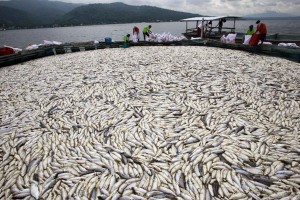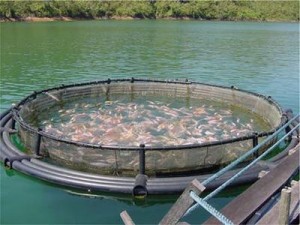The Environmental Impact of Aquaculture: A Dangerous Love Affair
I am super interested in the food industry so I wanted to talk about the fish farming industry, which is known as aquaculture. Aquaculture is a significant part of our diet and yet little is known about it by the general public. One quarter of all the fish eaten by humans in the world are raised on farms. Fish farming can be seen as a way to increase the world supply of protein and it can reduce the pressure of fishing on wild stocks; also if done sustainably, aquaculture could provide nutrient-rich waste water for local farmers. When properly managed, fish farms can have minimal impact on the environment and be a great provider of protein. But fish farming, especially outside of the United States, isn’t regulated tightly, so it often has a great negative impact on the environment, the economy and consumers. Because of this, fish farming is more detrimental than it is beneficial to our world as of now.
 Carnivorous farmed fish, like salmon and shrimp,that are highly desirable in consumer markets, require enormous amount of wild caught fish in order to grow and live, this is problematic because this practice is actually depleting, rather than supplementing, the world supply of protein. Fishmeal is a processed combination of herring, mackerel, sardines and other small fish caught in the wild. While there is some discrepancy between researchers about the true ratio, the range is that for every pound of fish raised solely on fishmeal requires the extraction of anywhere from two to ten pounds of fish from oceans and rivers. Some field experts, like Kentucky State University biologist James Tidwell, the former president of the World Aquaculture Society, say that though salmon eat up to ten pounds of fishmeal to gain a single pound, collecting enormous amounts of short-lived species like menhaden is no more damaging than mowing the lawn, “Fish-meal fish are nature’s forage…cropping them merely increases their productivity.” This ratio means that carnivorous fish actually consume more fish than they produce; rather than adding to the world supply of protein they are subtracting at a potentially exponentially high rate.
Carnivorous farmed fish, like salmon and shrimp,that are highly desirable in consumer markets, require enormous amount of wild caught fish in order to grow and live, this is problematic because this practice is actually depleting, rather than supplementing, the world supply of protein. Fishmeal is a processed combination of herring, mackerel, sardines and other small fish caught in the wild. While there is some discrepancy between researchers about the true ratio, the range is that for every pound of fish raised solely on fishmeal requires the extraction of anywhere from two to ten pounds of fish from oceans and rivers. Some field experts, like Kentucky State University biologist James Tidwell, the former president of the World Aquaculture Society, say that though salmon eat up to ten pounds of fishmeal to gain a single pound, collecting enormous amounts of short-lived species like menhaden is no more damaging than mowing the lawn, “Fish-meal fish are nature’s forage…cropping them merely increases their productivity.” This ratio means that carnivorous fish actually consume more fish than they produce; rather than adding to the world supply of protein they are subtracting at a potentially exponentially high rate.
Another issue with farmed fish is that the containing systems are often elementary at best. Farmers utilize nets that can easily tear with age, in storms, or just with some effort exerted by wild predators or the farmed fish themselves. This is a problem in that escapees can become a part of nearby wild populations; potentially threatening the integrity of the native fish’s gene pool. McCarthy, head of the Los Angeles World Affairs Council, wrote in a Times article his concerns with hybrid fish being introduced into wild populations. McCarthy analyzes the benefits and disadvantages of aquaculture. The article explores the problems associated with fish farming, like how detrimental the current practices are to the wild populations of fish and the water they live in, it also investigates why fish farming is still practiced, and concludes that the practice is simply highly profitable and it feeds our growing world. He concludes that with higher standards, fish farming could prevent the depletion of wild fish and help feed the masses. He also asserts that the consequences of this controversial practice vary from species to species and location to location and they really aren’t well understood yet. However, researchers have observed negative effects.
Some fish are farmed in ecosystems that they are not naturally found in; in this scenario escaped fish have been known to threaten, reduce or even wipe out native populations. Escapees sometimes eat the young of other species or the plants that native species rely on. And although wild male salmon are much more successful breeders than their captive cousins, one study of salmon in Norway found that when farmed males did succeed in producing hybrid offspring, the hybrid males were smaller than their wild counterparts, which enabled them to sneak in and fertilize females’ eggs without being noticed (McCarthy). This means that the second-generation escapee is four times more likely to reproduce; and dilute the natural gene pool of characteristics that have helped wild salmon survive for generations (Stier). Dany Garant, an ecologist at the zoology department of Oxford University in England says that “[the hybrid offspring] have a higher growth rate and are more aggressive than wild parr… [and] they don’t respond as much to the risk of predation.” Meaning the hybrid offspring are potentially easy targets in the natural environment, even though they grow more quickly and are more aggressive than their natural counterparts.
Because of the dense population of fish kept in unnaturally close quarters in farms, there is a high risk for disease, therefore to lower the risk of death and disease (and huge profit loses) farmers include antibiotics in the diets of the fish. One major problem with the continual use of industrial antibiotics is that these drugs are highly toxic to the environment and to human consumers. Wu, head of the Biology and Chemistry Department at City University of Hong Kong, found that antibiotics seep into surrounding waters and add to the pollution created by aquaculture. The antibiotic, chloramphenicol, which has been banned, can potentially cause fatal anemia in humans, and can detrimentally harm the environment. Traces of this harmful drug were discovered in fish from countries with fewer regulations than the U.S. (Fisheries Research Services). Obviously this is a huge negative for aquaculture. Yet, this was not discussed in the major American media. The fish were not required to be recalled, so news stations ignored the controversy and the potentially grave impacts to consumer health.
Wild fish are not fed antibiotics because they don’t live in unnaturally close quarters and more importantly… they are wild, they aren’t fed anything. This means there is less risk for consumers if they buy wild caught fish. On the other hand wild procuring methods can kill unintentional victims like dolphins and sea turtles which are protected from intentional fishing. Wild caught also means the reduction in wild populations of fish which are already dwindling at exponential levels (McCarthy).
Yet another issue with fish farming is nutrient loading. Wu asserts that food wastage is one of the most important sources contributing to organic and nutrient loading. Also much of the Carbon, Phosphorus and Nitrogen in fish food is lost in the environment, which pollutes the natural balances; it was determined that about 80% of Carbon, 76% of Nitrogen and 82% of Phosphorus were lost to the environment. Wu concludes that “It is obvious that regardless of species and culture methods, marine fish-farming generates a very high pollution loading. Feed wastage and pollutant loadings are much higher in open-sea cage culture systems where trash fish is used as feed.”
So, how can we enjoy fish, increase the world supply of protein, and go about this safely? There are many solutions generated by carefully research that we as consumers should advocate for. Wu concluded that Marine fish culture can be a sustainable development. His caveat to this bright conclusion was that pollution loadings generated by fish farms must be kept well below the carrying capacity of the water body. He said this can be achieved “by careful site selection, control of stock density, improved feed formulation and integrated culture (with macroalgae, filter-feeders and deposit-feeders).” He also stated that continued monitoring should be in place to ensure the continued success of farms.
In addition to Wu’s suggestions, one solution generated by researchers is fully enclosed, hard-walled pens for the fish to live in. Naylor, Director of the Center on Food Security and the Environment and Professor of Economics at Stanford along with Goldburg, director of Pew’s ocean science work, released recommendations on U.S. aquaculture policy in 2007. These highly decorated researchers suggest in a proposal to policy makers that hard walled pen systems should be instituted across the board. This would keep disease away from wild stocks, which has been a major issue in the past. This would also keep waste water and antibiotics from polluting surrounding waters. Additionally this would keep the river bed/ocean floor from being destroyed by the high concentration of sediment that accumulates. Lastly this would keep predators out and ensure there are no escaped fish.
So, what should we do as consumers? Be informed. The more conscious we are as consumers with our purchasing power the more we can and will change. Money talks. As advancements and population growth marches on, fish farming will become a bigger and bigger portion of the way protein is added to our ever growing world. This means it’s up to us to not let this growing industry kill our planet and us. We have to make sure that we exercise our right to be informed consumers and work to make conscientious decisions based on research, ethics and logic, not just price. This problem comes with solutions, though they cost more than carefree aquaculture, we have to be willing to make a small sacrifice (a few extra cents per pound) in order to lessen our impact on the world around us and on our own health.
Works Cited
Charles, Dan. “The Future Of Clean, Green Fish Farming Could Be Indoor Factories.” All Things Considered. NPR. 10 Apr. 2014. Radio.
“Environmental Impact of Fish Farming.” Fisheries Research Services – An Agency of the Scottish Exectutive, 1 Feb. 3. Web. 11 Dec. 2015.
“Factory Fish Farming.” Food & Water Watch. N.p., 16 Sept. 2015. Web. 14 Dec. 2015.
Marks, Robin. “In-depth: Fish Farming.” PBS. PBS, 12 Mar. 2008. Web. 13 Dec. 2015.
McCarthy, Terry. “Is Fish Farming Safe?” Time Magazine 17 Nov. 2002. Print.
Mercola, Dr. “9 Things You Should Know About Farmed Fish.” Mercola.com. N.p., 21 Dec. 2013. Web. 14 Dec. 2015.
Goldburg, Rebecca, and Rosamond Naylor. “Future Seascapes, Fishing, and Fish Farming.” Frontiers in Ecology and the Environment: 21. Print.
Stier, Ken. “Fish Farming’s Growing Dangers.” Time. Time Inc., 19 Sept. 2007. Web. 12 Dec. 2015.
Wu, R.s.s. “The Environmental Impact of Marine Fish Culture: Towards a Sustainable Future.” Marine Pollution Bulletin (1995): 159-66. Print.
Welsh, Jennifer. “The Disgusting Truth About Fish And Shrimp From Asian Farms.” Business Insider. Business Insider, Inc, 23 Oct. 2012. Web. 14 Dec. 2015.